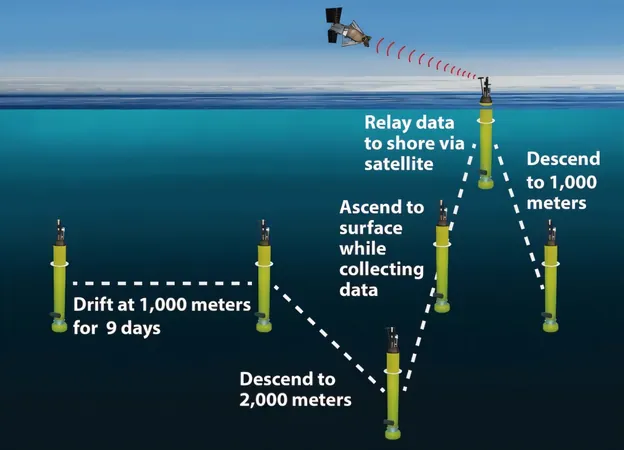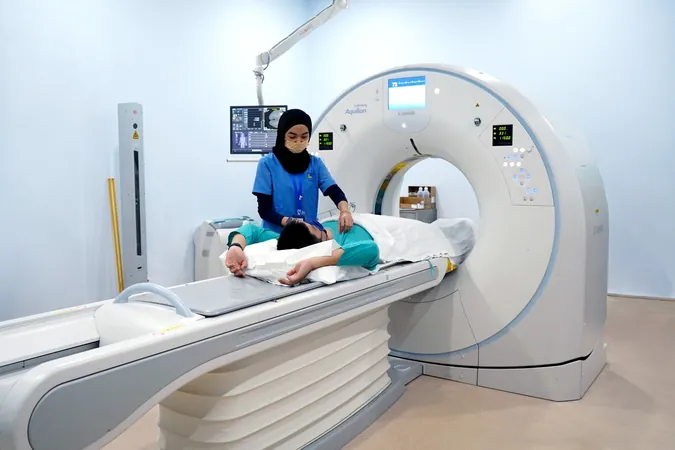
Revolutionary AI Unveils Secrets of Carbon Cycling in the Southern Ocean!
2025-08-27
Author: Rajesh
Unlocking the Secrets of Our Planet's Temperature Regulator
The Southern Ocean is a powerhouse in the fight against climate change, playing a crucial role in global carbon cycling. Understanding how this ocean exports carbon is vital for predicting climatic shifts and strategizing ocean-based climate solutions.
The Carbon Superhighway: A Hidden Lifeline
Imagine invisible highways coursing beneath the sea, transporting carbon from the atmosphere to the ocean floor—this is what scientists call the "carbon superhighway." This process is essential for our climate, storing carbon dioxide for decades to centuries. However, accurately measuring the effectiveness of this pathway has long posed challenges, especially in some of the most remote waters on Earth.
Breakthrough Study Reveals New Insights!
In a groundbreaking study led by MBARI Postdoctoral Fellow Guillaume Liniger, researchers have harnessed advanced machine learning techniques in collaboration with the University of Washington's CICOES and the SOCCOM project. Their findings illuminate ocean productivity and enhance our understanding of carbon export in the Southern Ocean.
The research, published in *Global Biogeochemical Cycles*, reveals that the annual net community production (ANCP) has seen a significant uptick—growing by nearly 1% annually from 2004 to 2022. Astonishingly, the Southern Ocean now exports about 3.91 billion metric tons of carbon each year, with traditional estimates potentially underestimating actual carbon export by up to one-third!
The Ocean's Global Impact and Its Challenges
While the Southern Ocean only occupies a third of the globe’s ocean surface, it absorbs a significantly larger share of the planet's carbon. Strong winds and currents churn nutrient-rich waters to the surface, fueling bursts of phytoplankton growth that capture atmospheric carbon.
SOCCOM: The Eyes Beneath the Waves
The Southern Ocean Carbon and Climate Observations and Modeling (SOCCOM) initiative, launched by the Scripps Institution of Oceanography, has deployed over 300 autonomous profiling floats fitted with sensors that monitor essential ocean variables since 2014. These innovative instruments furnish scientists with year-round data in an area where historical measurements are sparse.
AI Takes Center Stage!
What sets this study apart? The researchers trained an artificial neural network to identify patterns in nitrate data, a crucial nutrient for phytoplankton, which in turn is vital for carbon export estimations. By utilizing the rich dataset provided by BGC-Argo, they could produce reliable nitrate estimates across the Southern Ocean.
A Surprising Discovery and Its Implications
The results shocked many: the Southern Ocean is not only exporting substantial amounts of carbon, but this capacity is on the rise! Furthermore, previous methods that only examined seasonal nitrate changes overlooked nearly 38% of carbon exports. These revelations shift how scientists approach global carbon assessments, with significant ramifications for climate modeling.
Global Data Sharing for a Collective Impact
Both MBARI and SOCCOM champion free access to their data, underscoring the collaborative effort required to understand the Southern Ocean's climate regulation. This approach not only benefits scientific research but empowers policymakers with the tools necessary to address climate challenges.
Looking to the Future: Monitoring Climate Change
As we face the rapid onset of climate change, monitoring the Southern Ocean's carbon dynamics is more crucial than ever. This novel machine learning approach promises to refine our understanding of long-term trends, helping us anticipate future shifts in this vital ecosystem.
By bringing to light the often-invisible flows of the carbon superhighway, researchers aim to enhance public understanding and decision-making regarding climate interventions and sustainable management of our planet's precious oceans.




 Brasil (PT)
Brasil (PT)
 Canada (EN)
Canada (EN)
 Chile (ES)
Chile (ES)
 Česko (CS)
Česko (CS)
 대한민국 (KO)
대한민국 (KO)
 España (ES)
España (ES)
 France (FR)
France (FR)
 Hong Kong (EN)
Hong Kong (EN)
 Italia (IT)
Italia (IT)
 日本 (JA)
日本 (JA)
 Magyarország (HU)
Magyarország (HU)
 Norge (NO)
Norge (NO)
 Polska (PL)
Polska (PL)
 Schweiz (DE)
Schweiz (DE)
 Singapore (EN)
Singapore (EN)
 Sverige (SV)
Sverige (SV)
 Suomi (FI)
Suomi (FI)
 Türkiye (TR)
Türkiye (TR)
 الإمارات العربية المتحدة (AR)
الإمارات العربية المتحدة (AR)